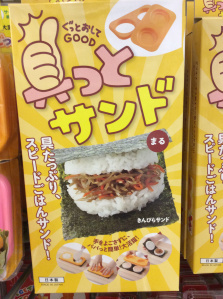Yangsze Choo's Blog, page 2
February 10, 2019
What’s it like to be interviewed on NPR?
Earlier this week I went to KQED to do an interview with Scott Simon for NPR’s Weekend Edition, to air Feb 9. I am a huge NPR fan and didn’t sleep much the night before (visions of listeners all over the country looking at each other and saying “who is this fool on the radio?”) 
January 29, 2019
The Ghost Bride on Netflix
Deep breath. Netflix is making THE GHOST BRIDE into a Chinese drama series!! It’s been sooo hard to keep this under wraps but now I can finally share it with all of you!! Aaaahhhhhh!!! I’m actually crying!! So excited!
Here’s a teaser trailer from NETFLIX.
And here’s the Netflix announcement plus Variety coverage.
November 13, 2018
THE NIGHT TIGER: A Starred Review from Kirkus!
I woke up to a wonderful surprise the other morning.
Mornings are often rushed, anxious affairs in our house, with one kid waking up late after having sworn the night before (while assembling Boba Fett armor out of cardboard and hot glue) that he had absolutely, positively, finished all his homework (not), and another child remarking plaintively that today was the PTA breakfast and where are the muffins for my class? All with chickens to be fed, lunches packed, and unwashed PE uniforms discovered in backpacks.
But the other morning was the best morning I’ve had, perhaps all year. It began with an email from my publisher, deftly and wonderfully titled: “Starred Kirkus review!!”
Oh!!
I gave a loud squeak of disbelief and joy. Then I read the email title again to make sure I wasn’t dreaming. No, I could still hear the faint shouts of children arguing in the distance.
Getting reviewed by Kirkus is a big deal. One of the biggest independent professional book reviewers, Kirkus also has a reputation for being tough. And a starred review! Awarded to Books of Exceptional Merit, apparently only 10% of books they review earn this. Never in my dreams… well, ok, the dreams in which I also fly and have the ability to teleport to sushi restaurants in Japan. I had to sit down, I was feeling so verklempt. Had I eaten all the chocolate in the house?
Writing is a solitary profession. “How do you come up with such… strange ideas?” I’ve often been asked. The answer is clearly spending too much time in one’s own head, or wandering around mumbling to oneself about tigers and what to serve at 1930s curry tiffins.
So it is with deep, deep gratitude that I’d love to share this review with you. Thank you Kirkus!! And thank you to all for coming on this journey towards pub date (Feb 2019!) with me.
July 8, 2018
THE NIGHT TIGER – a chocolate-fueled update!
[image error]It’s been a long time coming, but my second book is finally done and we have an official announcement! Hooray!!
For those kind and long-suffering readers and friends who’ve been on this journey with me, you’ll know that a few years ago I started saying things like “Oh ya, this book is almost done!” and stopping for mini-chocolate breaks. I was feeling optimistic because the plot included some of my favorite subjects: ghost stories, dead twins, Chinese dancehalls from the 1930s. And tigers. Lots and lots of tigers.
Many absorbing hours were spent in the National Archives of Singapore reading old newspapers on microfiche and trying to figure what the bounty was on man-eating tigers, and what kind of parties people were going to. In the meantime, my book got longer and longer and I started to feel very worried…
Apparently 100K words is a pretty good length for a novel. I’d hit 200K and was starting to panic. How was I going to shoehorn in all those plot twists? It was only thanks to the intervention of my wonderful agent Jenny Bent that this novel was wrestled into submission form. It was hard to leave many subplots and minor ghostly tales on the cutting room floor, but I think the end result is much, much better.
THE NIGHT TIGER sold at auction between 6 publishers to Flatiron Books (US/World) and as a pre-empt to Quercus (UK). It actually sold last summer, but the announcement was delayed until all the edits were in. I’ve been beyond thrilled to be working with my amazing editors – Amy Einhorn and Caroline Bleeke at Flatiron, and Cassie Browne at Quercus.
So, what’s this book about? I wrote a brief author’s note for my publisher’s advance reader copies, and would love to share it with you:
As a child in Malaysia, I was fascinated by the black and white colonial bungalows left behind by the British, many of which lie now in ruins. With their high ceilings and gracious windows, they spoke of a life that has vanished—a sort of Downton Abbey of the tropics with its shadowed interplay between servants and masters.
THE NIGHT TIGER came out of the secrets I imagined hidden in those houses together with many of my favorite obsessions: Chinese dancehall girls; twins; men who turn into tigers; a train that takes you to the world of the dead. And of course, a good mystery!
It took me four years to write this book because I’m a slow writer, but I loved being immersed in 1930s Malaya, a time and place that echoed with quick feet in the airy tiled hallways of hospitals, and the clink of glasses at dinner parties (I enjoyed researching the food a little too much). Where a houseboy could literally be a child of eleven, and belief in ghosts and lucky numbers could determine a marriage—or a murder.
Thanks for coming with me on this long journey. I’ll have more updates coming up soon! xoxo 
November 20, 2015
Late Night Coping Mechanisms
There’s been a long silence on this blog, not because I haven’t been eating and reading books, but because I’m almost done writing my second novel. I say this with some trepidation because to be honest, I’ve been claiming I’m “almost done” for a while. And all the time, my book keeps getting longer and longer and longer.
The good news is that I’m very excited about it, as I think it’s a strange and interesting tale. The bad news is, of course, I also thought the same thing about my ill-fated elephant novel, which featured a first person pachyderm detective.
“Why aren’t you done yet?” said my sister the other day. “How much longer is this book going to be?!”
“Um… I just need to kill off a few more people.” I said.
It’s a terrible thing to announce one’s progress to friends in terms of a literary body count, but as they pile up, I feel a certain freedom. Like a dog eagerly sticking its head out of the car window, I can smell it coming – hooray, the end of the book is nigh! Though of course I’m very sad to say goodbye to all these fictional people, and maybe, just maybe I can squeeze in an extra plot twist. This is when one must give one’s inner dog a sharp tap on the nose.
Chastised, I then recall telling my lovely and long-suffering agent that I’d send her something to read in August…of 2014. Now it’s November 2015 and my giant book is far too large to send to anyone without a good chopping. At least 60,000 words must go before I can show it to people without having them run away screaming in horror, so a few days ago I sat down and contemplated my manuscript. Hmm.
Then I got up and went to the fridge to find some “inspiration”.
Back again. Yes, I can do this! If I make “I am” and “He had” into things like “I’m” and “He’d” then I can get rid of lots of words. Ha ha!
Gloom as I realize that there aren’t enough contractions to save me.
More walking back to the fridge, dejectedly, to discover that all the dark chocolate inspiration has been eaten by my inner dog.
Needless to say, I’ve bounced between encouragement, excitement and also the pit of despair as I embark on the endgame to this novel. In fact late one night, I decided to make lots of quail egg bunnies (see above picture) to take my mind off the process. Note: the more elaborate my kids’ lunches, the more procrastinating I’ve done.
The good news is that the quail egg bunnies were cute and all the children loved them. The bad news is that they were too cute and they didn’t want to eat them. Which, I suppose, is sort of the same way I’m feeling about my novel. So I’ve told myself that now is the time to murder my darlings. Or at least, eat the darned things.
How to make quail egg bunnies:
Boil as many quail eggs as you want plus some extra. You can never have too many bunnies. Quail eggs cook fast so don’t overcook them. About 5 minutes should do it.
Peel them.
Cut a thin slice off the long side of the egg to make a flat bottom so your bunny won’t tip over.
Take the slice you cut off and cut a small V shaped bit off. This will be the bunny’s ears.
Cut a slit about 1/3 of the way along the egg from the pointy end (where you think the bunny’s head should be) and insert the ear piece. You’ll be surprised at how nicely it sticks up.
Add 2 small eyes made of black sesame seeds.
Present on a dish and watch as small children refuse to eat them.
What are your late night coping mechanisms?
If you enjoyed this post, please follow my blog, FB, or :)


May 8, 2014
How to Poach Eggs in Their Shells
A few days ago, we had some friends over for brunch and I decided to serve poached eggs on rice. “Is this going to be raw?” they asked in surprise, as I blithely started to crack eggs over the cooked rice in their bowls.
Fortunately, the eggs were actually poached but it made me realize that this method of poaching eggs in their shells is actually quite unexpected and delightful to many people. It’s also incredibly convenient, since you can make the eggs ahead of time and store them in their shells in the fridge.
In Malaysia, a favourite breakfast item is a soft-boiled egg served in a bowl with soy sauce and white pepper. Thick Hainanese toast, grilled over charcoal and lavishly smeared with butter and kaya, a caramelized custard spread, is the traditional coffee shop accompaniment together with piping hot coffee (or more scandalously, the subversive drink called chum, which is coffee and tea mixed together with condensed milk).
The eggs are soft set and I’ve adapted a way to cook them from traditional Japanese onsen tamago, where they are held at a low temperature so that the yolks and whites are just cooked. Egg whites and yolks cook at different temperatures, so the textures will be slightly different – the white will be very soft while the yolk will be set like a jelly. I heard that the local kopi tiams (coffee shops) also cook their eggs sous-vide style nowadays in large batches, although theirs seem a bit runnier. I prefer my eggs a little firmer but still tender, and it’s a great party trick to crack open an eggshell and slip out a perfectly poached egg!
These are delicious with a dash of soy sauce and freshly ground pepper, or wherever you need a poached egg. Best of all, they can be kept in the fridge and reheated in their shells in a bowl of warm water whenever you need them.
Poached Eggs in Their Shells (onsen tamago)
4 eggs
1 quart + 1 cup of water
A small pot deep enough to cover the eggs in water
Bring the eggs to room temperature by letting them sit out on the kitchen counter for a few hours. If I’m making this in the morning, I’ll just leave them out overnight.
Put 1 quart (4 cups) of water into a small pot and bring to a boil. When it comes to a full boil, turn OFF the heat and stir in 1 cup of cold tap water.
Add the eggs – I like to use a pasta scoop to add them gently – and quickly cover the pot with a lid.
Let the eggs sit in the pot for ~20 minutes with the heat OFF. If your ambient room temperature is very cold or warm, adjust the cooking time accordingly by a few minutes. You can let them sit longer, because they won’t overcook.
After 20 minutes, take out an egg and crack it into a bowl. A perfectly poached egg should slip out. Enjoy plain, serve on top of a bowl of hot rice, or any other way you like! This recipe is easily doubled as long as you have a pot that’s deep enough to completely cover the eggs in water. If the pot is too big, too much residual heat will be lost.
There are lots of other ways to cook onsen tamago, most of which involve fiddling around with thermometers in an attempt to keep the water at 140 F for 45 minutes (David Chang’s Momofuku recipe), but my mum has been making soft eggs like this for years without measuring anything, and it’s a lot easier.
I shared this recipe in an upcoming fundraiser cookbook for the Friends of the Otis Library, Norwich CT. They will have lots of recipes from other authors as well, and it’s a great way to support a library!

If you’ve always wanted to wrap eggs in rice straw, this is the book for you!
Book Suggestion:
How to Wrap 5 More Eggs – I received this book as a child and it consists of examples of traditional Japanese packaging. It sounds bizarre, but it’s actually a very beautiful book that showcases wrapping styles that are now almost extinct. A great coffee table book.
Food Suggestion:
Dress up your soft poached egg by making a fast version of Eggs Benedict – try serving it on a piece of buttered toast, with a slice of smoked salmon and a drizzle of Kewpie mayonnaise with lemon juice. If you have wafer thin sliced onions and a sprig of dill, it will be even better!
What’s your favourite way to eat poached eggs?
If you enjoyed this post, please follow my blog, FB, or :)


February 26, 2014
My Ill-Fated Elephant Detective Novel
Everyone has a mistake or two hidden in their closet. Mine just happens to be elephant-sized.
A number of people have very kindly (and probably untruthfully) expressed an interest in seeing my ill-fated elephant detective novel. This was the first book that I attempted to write, and it was a disaster.
I had grand plans for this book — it would feature a pachyderm detective who would unravel a series of mysterious deaths at a Chinese circus. Unfortunately I ran into a lot of logistical difficulties with my hero. He was constantly lurking around, extending an ear around the corner and forced to eavesdrop in order to get vital information about the crime. I just couldn’t get anywhere with the book because there was (literally) an elephant in the room. The final blow to this endeavour was when Water for Elephants was published. Despite the fact that it wasn’t a detective novel, there were so many similarities (circuses in the 1930s, crime and punishment amidst pachyderms) that I had to abandon it.
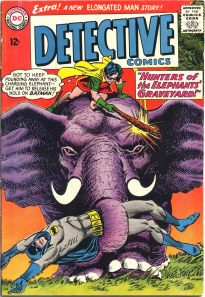
No, my book didn’t have Batman in it, but it might as well have.
Now that I look back on this first book, I can’t imagine what I was thinking. It was so enormously complicated that I could barely keep track of all the various plot points that, like an overloaded circus train, threatened to careen off the rails. Not to mention the fact that when people asked me what I was up to (I spent years writing this book, in a very dilatory fashion), the conversation would invariably go like this:
Them: “So what’s your book about?”
Me: “It’s about an elephant detective!”
Them: “A what? A person who finds elephants?”
Me: “No, a detective who IS an elephant.”
Them: silence….
Naively, I stumped along, believing that the world really needed more first-person narratives told by elephants. Of course, I turned out to be wrong, but not before I had sunk enormous amounts of time and energy into it.
I can’t tell you what a relief writing The Ghost Bride was in comparison. Now when people ask me what my book is about, I can launch into the fact that it’s about this peculiar historical practice of marrying the dead that Chinese people used to occasionally do. At this point they often still look interested, a sentiment that I hope will mysteriously compel them to rush off and read it, or at least, not back away quietly from me.
The funny thing about it is that some of the events in The Ghost Bride actually started out as a subplot for this first novel. I happened to be digging around in the archives of our local Malaysian newspaper when I came across a sentence which alluded to the decline of spirit marriages amongst the Chinese.
“What is this?!” was my first reaction. Never mind that there wasn’t anything about elephants in the article.
Then I realized that this must refer to the marriage of the dead. I’d vaguely heard of this before, since ghost stories are the weapon of choice for Chinese grandmothers, but this matter-of-fact reference was so intriguing that I sat down and wrote the first chapter pretty much as it appears in the book. Then I put it away, with all the bits and pieces of unfinished writing, but there was something about that short piece that kept drawing me back, even though I clearly couldn’t use it because it wasn’t written in first-person pachyderm.
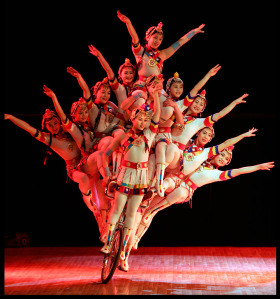
Try to imagine Tian Bai riding this unicycle. Or actually, please don’t.
Still, I was tempted to try to shoehorn this whole notion of a ghost bride back into my elephant novel (please don’t do things like this). In fact, Li Lan and Tian Bai were originally characters from that first book – Tian Bai was one of those Chinese acrobats who spin plates on sticks and form human pyramids. Yes, it was a truly terrible novel. I cringe when I reread bits of it. But I’m glad that I worked on it because without that long, strange sojourn, I might never have written The Ghost Bride, which thankfully shaped itself into a tale that was worlds away from where I started.
So whether you’re writing or reading, I’d like to encourage you to keep going. And don’t be afraid to make mistakes, even ones that weigh several tons and are unable to squeeze themselves into crime scenes.
P.S. Yes, I am writing another novel, which necessitates many trips to and from the refrigerator in search of “inspiration”. And no, it is not about elephants.
Book Suggestion:
Gerald Durrell’s Rosie is My Relative - a much better book about an elephant which is (intentionally) hilarious.
Snack Suggestion:
Peanuts, sugarcane, and bananas.
Photo credits: Photo 1 - http://www.livelimitless.net/tag/wild.... All other photos link back to original webpages.
Have you ever had the horrible suspicion that the project you’re working on is misguided?
If you enjoyed this post, please follow my blog, FB, or 

January 8, 2014
Play With Your Food
When I was a little girl, my sister and I loved to play with our food. We had to do this surreptitiously because my mum frowned upon anything that looked like wasting food or making a mess, but one of our favourite games, which could be played under the radar by two quiet little girls, was “The Giant’s Dinner”.
This consisted of recreating miniature meals on our spoons and pretending we were giants who being served by Lilliputians. Every spoonful was artfully arranged to look like a normal plate, with tiny bits of vegetables, rice, and meat, and we made up imaginary menus for our dishes. Needless to say, we were very slow eaters…
Years later, I discovered that there were many other delightful ways to play with your food, such as Joost Elffers’ books and calendars of the same name, and the world of cute kyaraben. The other evening, as I was prepping my kids’ school lunch for the first day of 2014, I thought it would be fun to make them a surprise. Never mind that this thought occurred almost directly after looking at the pile of work waiting on my desk (the source of many impulses, such as leaving the house to buy necessities like chocolate. Or deciding to wash the car).
Mushroom How-To:
 Our local Trader Joe’s has recently started to carry bags of colourful organic carrots, some of which are a nice deep red. Perfect for a fly agaric mushroom. I once actually found some growing in a forest and they are every bit as cute (and deadly) as you might imagine from watching cartoons.
Our local Trader Joe’s has recently started to carry bags of colourful organic carrots, some of which are a nice deep red. Perfect for a fly agaric mushroom. I once actually found some growing in a forest and they are every bit as cute (and deadly) as you might imagine from watching cartoons.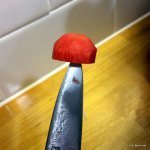 Peel your carrot of choice and cut into lengths about 1/2″ thick depending on the width of your carrot. Carve the tops so that they’re curved. It helps to have a sharp paring knife.
Peel your carrot of choice and cut into lengths about 1/2″ thick depending on the width of your carrot. Carve the tops so that they’re curved. It helps to have a sharp paring knife.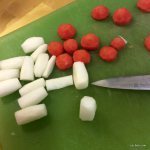 Make stems out of daikon. This large white radish is often found lurking around Asian kitchens where it’s used for everything from soup to salad. Daikon is supposed to detoxify your liver and promote digestion. It also happens to be a nice white colour and easy to carve. If you taper the mushroom stems at both ends, they’ll look more realistic.
Make stems out of daikon. This large white radish is often found lurking around Asian kitchens where it’s used for everything from soup to salad. Daikon is supposed to detoxify your liver and promote digestion. It also happens to be a nice white colour and easy to carve. If you taper the mushroom stems at both ends, they’ll look more realistic. Boil the vegetables in a little water until just tender. I separated the daikon and the carrots because I was worried that the carrots might bleed some colour onto the white stems, but it’s probably ok to mix them. I added a little salt to the daikon when I boiled them, and a little sugar to the carrots. Another option would be to serve them with some dipping mayonnaise.
Boil the vegetables in a little water until just tender. I separated the daikon and the carrots because I was worried that the carrots might bleed some colour onto the white stems, but it’s probably ok to mix them. I added a little salt to the daikon when I boiled them, and a little sugar to the carrots. Another option would be to serve them with some dipping mayonnaise.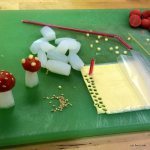 I tried cutting out bits of cheese with a straw for the spots, but they ended up looking strangely blobby. Plus, cutting the teeny bits of cheese was driving me crazy. White sesame seeds are better. For a completely seamless look, a piece of uncooked spaghetti inserted into the mushroom will hold it up nicely, although the pasta will soften over time. Or just use toothpicks.
I tried cutting out bits of cheese with a straw for the spots, but they ended up looking strangely blobby. Plus, cutting the teeny bits of cheese was driving me crazy. White sesame seeds are better. For a completely seamless look, a piece of uncooked spaghetti inserted into the mushroom will hold it up nicely, although the pasta will soften over time. Or just use toothpicks.The next morning, assemble the bento: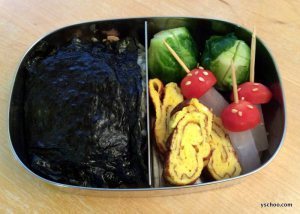
The brussels sprouts were scored with an X on the stem, tossed lightly in olive oil and sea salt, and microwaved for 2 minutes with a little water.
I made tamagoyaki (sweet egg omelette) using this recipe from one of my favourite blogs.
The dark thing on the left is a rice sandwich with ginger pork filling, wrapped in nori (seaweed). The pork was from dinner the night before, so it only had to be reheated. You can just pack leftovers for the main dish, which is what I usually do for kids’ lunches. I like the colour of the seaweed, which makes it look mysteriously woodsy. Or just black.
This was also a fun chance to try out the rice sandwich mold I found the other day at Marukai Market. Put hot steamed rice in and press to shape. It’s surprisingly easy and somewhat addictive to make. I had to stop myself from pressing out lots of these cute sandwiches, which can be filled with whatever you like. If packed for school, the seaweed does get a bit soggy but my kids didn’t seem to mind.
I must confess it’s hard to say who had more fun with their lunch, the kids or me – although I had to caution them not to expect something like this more than, um, once a year.
Book Suggestion:
Play With Your Food , by Joost Elffers. These adorable pictures of vegetables crafted into different animals will ensure you never look at produce the same way again.
Food Suggestion:
If you’re not up to something elaborate, a piece of fruit or carrot and celery sticks with peanut butter.
Happy new year, everyone! Here’s wishing you a tasty and delightful 2014!


November 7, 2013
What to Eat If Your Book is Nominated for an Award?
I was very surprised and excited to hear that my book, The Ghost Bride, has been nominated for the CILIP Carnegie Medal and Goodreads Choice Awards for Best Debut and Best Fantasy. I happened to be in Singapore for the Singapore Writers Festival, and heard the news just as I was about to head off in search of something to eat.
“What?!” I said. The Carnegie Medal is one of Britain’s oldest and most prestigious children’s book awards, the UK equivalent to the Newbery Medal. The Goodreads Readers’ Choice Awards are an amazing reader endorsement. I took a look at the other titles on these lists. Wonderful books written by talented and famous authors. Wow! I don’t know what happened to the universe, but to be named alongside them is really quite unbelievable to me.
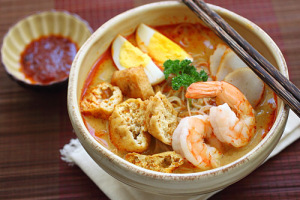
Curry laksa – eat with a spoon to slurp up the delicious broth and fried tofu puffs (click for recipe from rasamalaysia.com)
To recover from the shock, I rushed out to eat a plate of nasi lemak, which is rice cooked in coconut milk and accompanied by things like hard boiled eggs, roasted peanuts, and spicy sambal. The classic accompaniment is chicken curry, but it’s terrific with fried chicken. Fried local chicken is a smaller bird than what you see in America, and is far more tasty, with delicate little wings and drumsticks to nibble on. In fact, the local KFC is a good stop if you’re in Malaysia or Singapore and want to do some “scientific comparisons”.
Singapore is not the kind of place you should visit if you are on a diet. There is too much good food – every shopping center is judged by its anchor restaurants and food eateries. While I was there, I had about 4-6 mini-meals a day. Things like curry laksa, prawn mee, sup kambing, all washed down with copious amounts of ice Milo and fresh coconut water. I was careful to avoid weighing myself, thus remaining cheerful.
The Best Crab in the World
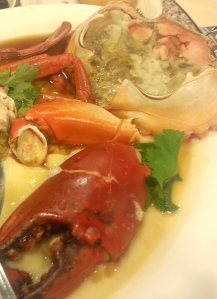
Steamed Sri Lankan crab for the purist – each claw was about the size of my hand.
Singapore is also the place to eat one of the best crustaceans in the world – the mangrove crab. This muddy delicacy is found in the warm waters of SE Asia, but the finest and largest specimens come from Sri Lanka. I went with my sister and her family to eat both steamed and chili crabs at Long Beach Restaurant. She explained that although the rest of the food was “ok”, the real draw was the quality of crabs, thanks to their crab buyer (or whatever arrangement they have with sourcing). And she was right, as the crabs we ate that night were bursting with meat, obviously just taken before their shells molted.
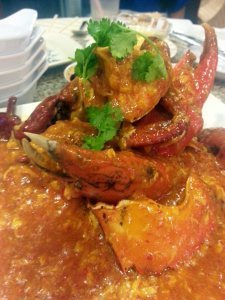
Chili crab looks like a Japanese horror movie but tastes fantastic.
I always like to eat at least one crab plain steamed. This is the best way to judge quality, as the restaurant can’t substitute dead or dying crabs for this dish. We also had chili crab, which is delicious eaten with deep fried man tou (steamed buns) to sop up the sauce. Unfortunately chili crab is not very photogenic, as it resembles an orange goopy mess, but it disappeared so fast that all that was left was the spicy, sweet sauce which we shoveled into takeout boxes for a midnight snack on French baguettes
I’d like to go on and tell you about breakfasts comprised of soft boiled eggs with soy sauce and white pepper, and lots of kaya toast pressed together over thin slabs of butter, but I should also be honest and admit that all this indulging came at a price. Even a few days there caused my clothes to mysteriously shrink and my wallet to empty out. Singapore, alas, is not a cheap city, but well worth visiting if you can control yourself…
In the meantime, I am so thrilled and deeply grateful to be nominated for these book awards. I never imagined that something like this could happen (the Carnegie Medal nomination is for the UK Young Adult version of my book). The Goodreads Choice Awards are chosen by readers, so please stop by and vote - there are so many wonderful books! The Ghost Bride is up for Best Fantasy and Best Debut, and the first round of voting is from Nov 4-9. 


October 28, 2013
Instant Ramen Deluxe – the Lobster Edition
When I was a university student, I once organized a kung fu/ramen party. This consisted of renting martial arts movies and providing a wide variety of instant noodles to eat along with the action. “What kind of party is this?” said my then boyfriend (now husband). I explained to him that it was a great way to combine two of my favourite pastimes. He looked at me incredulously while a steady stream of people filtered in, many of whom expressed surprise upon discovering I was the host and not some Korean guy named “Yong Suh Cho”.
I’ve always had a weakness for instant ramen. Despite the fact that it is one of the most highly processed, nutritionally deficient foods around, containing on average about 500 calories of fat, carbs and enough sodium to recreate the Dead Sea in your stomach. Most instant noodle packages coyly describe themselves as containing “2 servings” so they can declare only half the horrifying calories, but who actually eats half a packet at a time? Still, there’s something so addictive about it that I can’t help giving into the dark side more than I should.

The amazing variety of instant ramen!
So what type of instant ramen should you buy? This is a serious question given the mind-boggling variety that every Asian grocery seems to stock. At first, (a la Cook’s Illustrated) I thought about systematically taste-testing a dozen brands. However, this is impossible since, sadly, I’m no longer 18 and would probably pass out from an extended ramen diet.
Instead, here are a few tried-and-true brands that I like. My #1 chicken flavour ramen is Nissin’s chu qian yi ding (出前一丁). Closely followed by Sapporo Ichiban. I also have a soft spot for the sesame flavour in both these brands. For spicy, there’s nothing like the classic Nongshim Shin Ramyun Black Label ramen which claims to have no MSG but is still insanely delicious. I also enjoy Nongshim’s Kimchee Ramyun which hits some sour and spicy notes, especially good with a cup of hot tea laced with condensed milk.
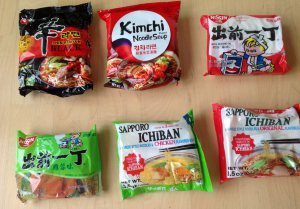
Some favourite brands. Try them all if undecided.
There is no “best” way to eat ramen. The terrible thing is that it almost always tastes good, whether eaten guiltily at midnight, or from a styrofoam cup in an aeroplane. My fallback method is to boil some water and gently poach an egg. When your egg is almost done, add some green vegetables and then your ramen. What I’ve learned over the years is to follow the timing on the packet. It stands to reason that this artificially engineered tastiness follows strict parameters, so if 出前一丁 says cook for 4 minutes, then you should set your timer for it.
Recently, I’ve discovered a new way to enjoy ramen. Since it’s become an occasional indulgence, like foie gras or french fries, I decided I might as well go all out and eat it with lobster. Lobster is unbelievably good with Black Label Shin Ramyun. There’s something about the spicy decadence that sets off the sweet, succulent lobster. It’s so good, I don’t know why some fancy restaurant hasn’t started serving it in an egg cup as an amuse bouche.
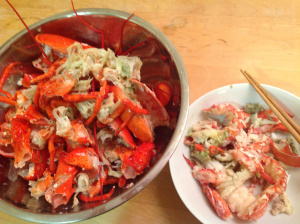
Removing the meat from your lobster. Even better, ask someone else (like a long-suffering spouse) to help you…
Deluxe Ramen with Lobster:
The day before, go to your local Asian grocery and collect all the ramen brands pictured above. You will only need the Black Label Shin Ramyun, but since you’re there, you might as well stock up.
Also, buy a live lobster or two from the tank. If the Chinese guy tells you he only has 3 lb monsters in the tank, just keep asking him sweetly to look. 1.5-2 lbs a good size. Over 2 lbs gets a bit tough.
Go home and steam your lobster. I like to do this late at night, when my children are asleep and can’t ask me things like “Mummy, can I keep this as a pet?”.
There are lots of good Youtube videos on how to steam your lobster, but I usually put it in the freezer, then dispatch it with a butcher knife through the thorax before steaming. It seems less cruel to have a quick comatose death than be lowered alive into a boiling pot.
After steaming, remove all the lobster meat as well as the delicious green tomalley and coral roe if there is any. At this point, I usually have a nice late night lobster snack which is why you might as well cook two instead of one.
The next day, cook your Shin Ramyun instant noodles according to the packet. Garnish with lobster, broccoli, and hard boiled quail eggs. Inhale the spicy aroma and eat steaming hot, while fanning yourself and mumbling “this is sooo good!”. Do not share.
Book Suggestion:
Haruki Murakami’s Hardboiled Wonderland and the End of the World. One of my favourite novels, where the protagonist is literally in two minds, this goes deliciously well with the high end/low end appeal of lobster ramen.
Later this week, I’ll be in Singapore for the Singapore Writers Festival 2013. I’m looking forward to some great panel discussions as well as tasty local noodles (in preparation, I’m packing some roomy, smock-like clothes). If you’re in town, please come by – it looks like a wonderful line up of international authors. I’ll also be giving a book talk at the National Library (central branch) on Friday Nov 1st.
What’s your favourite brand of instant noodles?
If you enjoyed this post, please follow my blog, FB, or :)



